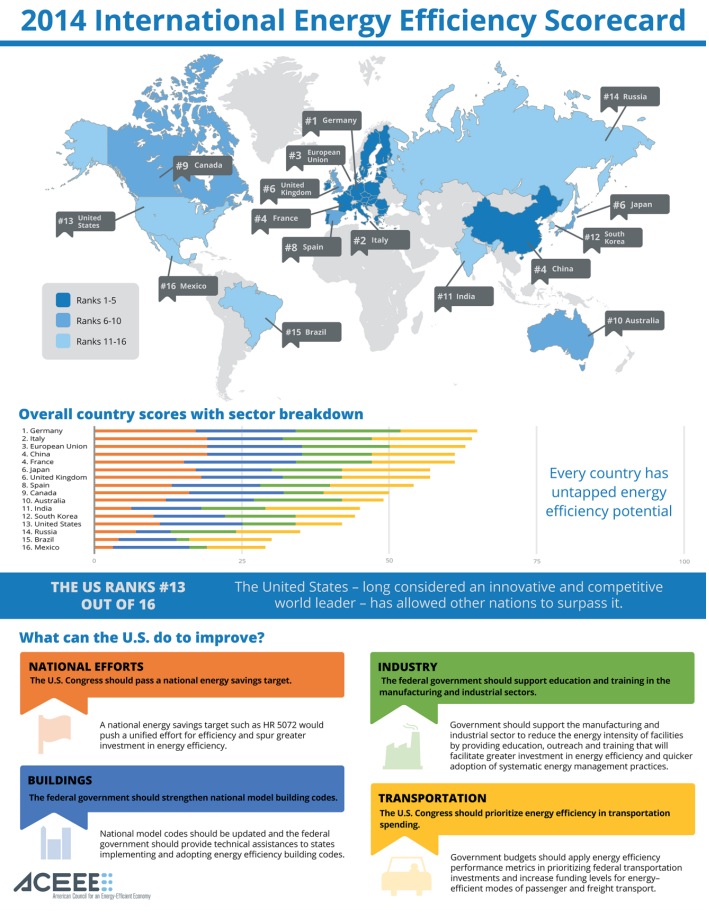AMERICAN COUNCIL FOR AN ENERGY-EFFICIENT ECONOMY (ACEEE)
Executive Summary
A country that uses less energy to achieve the same or better results reduces its costs and
pollution, creating a stronger, more competitive economy. While energy efficiency has
played a role in the economies of developed nations for decades, cost-effective energy
efficiency remains a massively underutilized energy resource.
In this second edition of the International Energy Efficiency Scorecard, we analyze the world’s
16 largest economies covering more than 81% of global gross domestic product and about
71% of global electricity consumption. We looked at 31 metrics divided roughly in half
between policies and quantifiable performance to evaluate how efficiently these economies
use energy. The policy metrics were scored based on the presence in a country or region of a
best-practice policy. Examples of policy metrics include the presence of a national energy
savings target, fuel economy standards for vehicles, and energy efficiency standards for
appliances. The performance metrics are a measure of energy use and provide quantifiable
results. Examples of performance metrics include average miles per gallon of on-road
passenger vehicles and energy consumed per square foot of floor space in residential
buildings. The metrics are distributed across the three primary sectors responsible for
energy consumption in an economically developed country: buildings, industry, and
transportation. We have also included a number of metrics that cut across these sectors
(such as the efficiency of electricity generation) and that indicate a national commitment to
energy efficiency. These metrics are included in a national efforts section. The maximum
possible score for a country is 100 points, and we allocated 25 points to each of these four
sections, assigning a point value to each metric. We then scored and ranked all economies
based on the results of our research.
Germany has the highest overall score, with 65 out of 100 possible points. The top-scoring
countries in each category are: China in buildings, Germany in industry, Italy in
transportation, and a three-way tie between France, Italy, and the European Union in
national efforts.
Our results indicate that some countries are significantly outperforming others, but the
more important finding is that there are substantial opportunities for improvement in all
economies analyzed. The conditions required for a perfect score are currently achievable
and in practice somewhere on the globe. For every metric, at least one country (and often
several) received full points. However, every country also has serious weaknesses, and the
average score was just 50 points.
Understanding exactly why countries scored and ranked where they did requires a detailed
look at the metrics; however, generally, the top-scoring countries scored solidly across all
four sections.
The United States has made some progress toward greater energy efficiency in recent years,
particularly in areas such as building codes, appliance standards, voluntary partnerships
between government and industry, and, recently, fuel economy standards for passenger
vehicles and heavy-duty trucks. However, the overall story is disappointing. The United
States, long considered an innovative and competitive world leader, has progressed slowly
and has made limited progress since the last International Scorecard in 2012. In contrast,
countries including Germany, Japan, and China are surging ahead. Countries that use
energy more efficiently use fewer resources to achieve the same goals, thus reducing costs,
preserving valuable natural resources, and gaining a competitive edge over other countries.
In the United States, a great deal of resources are wasted, and costs have been allowed to
remain unnecessarily high.
The inefficiency in the U.S. economy means a tremendous waste of energy resources and
money. Across most metrics analyzed in this International Scorecard, in the past decade the
United States has made limited progress toward greater efficiency at the national level. The
overall U.S. score of 42 is less than half of the possible points and is 23 points away from the
top spot. Further, the United States falls behind Canada, Australia, India and South Korea.
These scores suggest that this list of countries may have an economic advantage over the
United States because using less energy to produce and distribute the same economic
output costs them less. Their efforts to improve efficiency likely make their economies more
nimble and resilient. This raises a critical question: looking forward, how can the United
States compete in a global economy if it continues to waste money and energy that other
industrialized nations save and can reinvest? This report offers a number of
recommendations for the United States. Figure ES-1 shows a high level snap shot of the
results of the report and four major opportunities for the United States.
Download full version (PDF): 2014 International Energy-Efficiency Scorecard
About the American Council for an Energy-Efficient Economy (ACEEE)
www.aceee.org
The American Council for an Energy-Efficient Economy (ACEEE), a nonprofit, 501(c)(3) organization, acts as a catalyst to advance energy efficiency policies, programs, technologies, investments, and behaviors. We believe that the United States can harness the full potential of energy efficiency to achieve greater economic prosperity, energy security, and environmental protection for all its people.
Tags: ACEEE, American Council for an Energy-Efficient Economy







 RSS Feed
RSS Feed